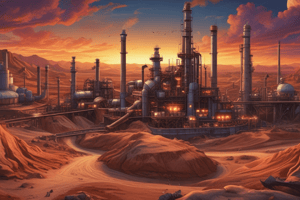Podcast
Questions and Answers
What is the primary purpose of secondary methods in oil and gas production?
What is the primary purpose of secondary methods in oil and gas production?
- To decrease the friction between the unrecovered oil and the reservoir surface
- To increase the oil viscosity or support its movability (correct)
- To extract oil and gas resources by traditional drilling methods
- To reduce the reservoir complexities
What is the purpose of water flooding in oil and gas production?
What is the purpose of water flooding in oil and gas production?
- To heat up the reservoir
- To increase the viscosity of the unrecovered oil
- To push the unrecovered oil resources towards the wellbore (correct)
- To inject pressured fluids into the reservoir
What is the benefit of using 3D seismic technology in oil and gas exploration and development?
What is the benefit of using 3D seismic technology in oil and gas exploration and development?
- To analyze very large areas of oil and gas resources three dimensionally (correct)
- To reduce the reservoir complexities
- To study the reservoir geology with two-dimensional seismic data
- To analyze small areas of oil and gas resources
What is the primary energy source for the world?
What is the primary energy source for the world?
What is the purpose of hydraulic fracturing in oil and gas production?
What is the purpose of hydraulic fracturing in oil and gas production?
What is the primary purpose of Edwin Drake's first discovery of oil in Titusville, Pennsylvania?
What is the primary purpose of Edwin Drake's first discovery of oil in Titusville, Pennsylvania?
What is an example of a secondary method in oil and gas production?
What is an example of a secondary method in oil and gas production?
What is the purpose of CO2 injection in oil and gas production?
What is the purpose of CO2 injection in oil and gas production?
What is an example of the use of oil and natural gas?
What is an example of the use of oil and natural gas?
What is the benefit of using directional drilling in oil and gas production?
What is the benefit of using directional drilling in oil and gas production?
Flashcards are hidden until you start studying
Study Notes
Formation of Oil and Natural Gas Reserves
- Organic content of organisms becomes fossil fuels through geological processes.
- Hydrocarbons form through generation of crude oil, heavy oil, and natural gas in sedimentary rocks over millions of years.
- Source rocks and reservoir rocks must be explored by geologists specializing in stratigraphy, sedimentology, structural geology, seismology, and petroleum geology.
Exploration and Extraction
- Hydrocarbons are trapped in deep subsurface reservoirs and require integrated teams of geologists and engineers to explore and extract.
- Advanced instruments and computer software are used to calculate reserve estimates.
- Fossil fuels are non-renewable resources that cannot be replaced.
Types of Oil Reserves
- Proven reserves: 90% recoverable oil and gas reserves with existing data and technology.
- Unproven reserves: discovered resources with significant uncertainties due to political and administrative issues.
- Proven reserves can be subdivided into developed and undeveloped reserves, while unproven reserves can be subdivided into probable and possible reserves.
Technology in Oil and Natural Gas Extraction
- Traditional methods involve vertical drilling and pumping, with crude oil flowing up through the wellbore.
- Secondary methods use horizontal, lateral, or directional drilling to increase producible reservoir area.
- Examples of secondary methods include water flooding, CO2 injection, steam flooding, polymer flooding, and hydraulic fracturing.
Uses of Oil and Natural Gas
- Oil and natural gas are used in transportation, heating, industrial developments, petrochemical and manufacturing industries, and food production.
- Examples of oil and natural gas usage include gasoline, diesel fuel, jet fuel, heating oil, waxes, lubricant oils, asphalt, synthetic rubber, plastics, petroleum coke, heating, and electric generation.
Studying That Suits You
Use AI to generate personalized quizzes and flashcards to suit your learning preferences.




